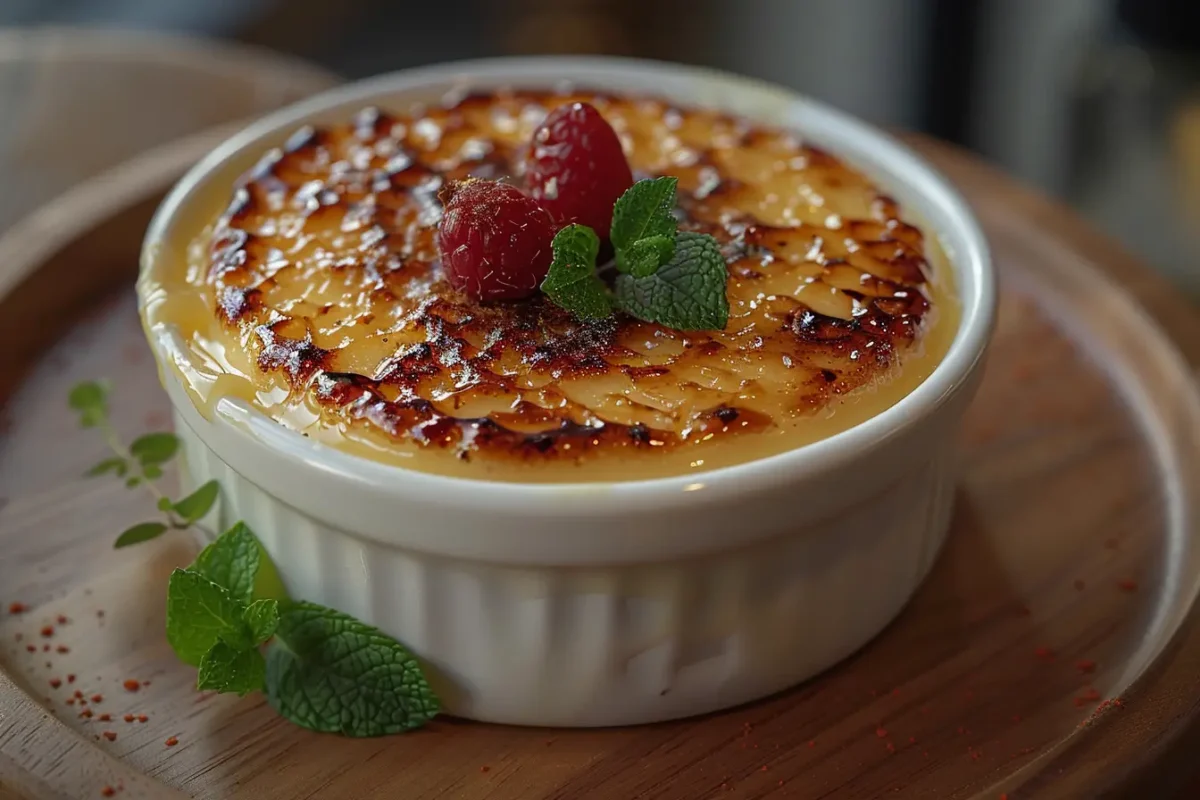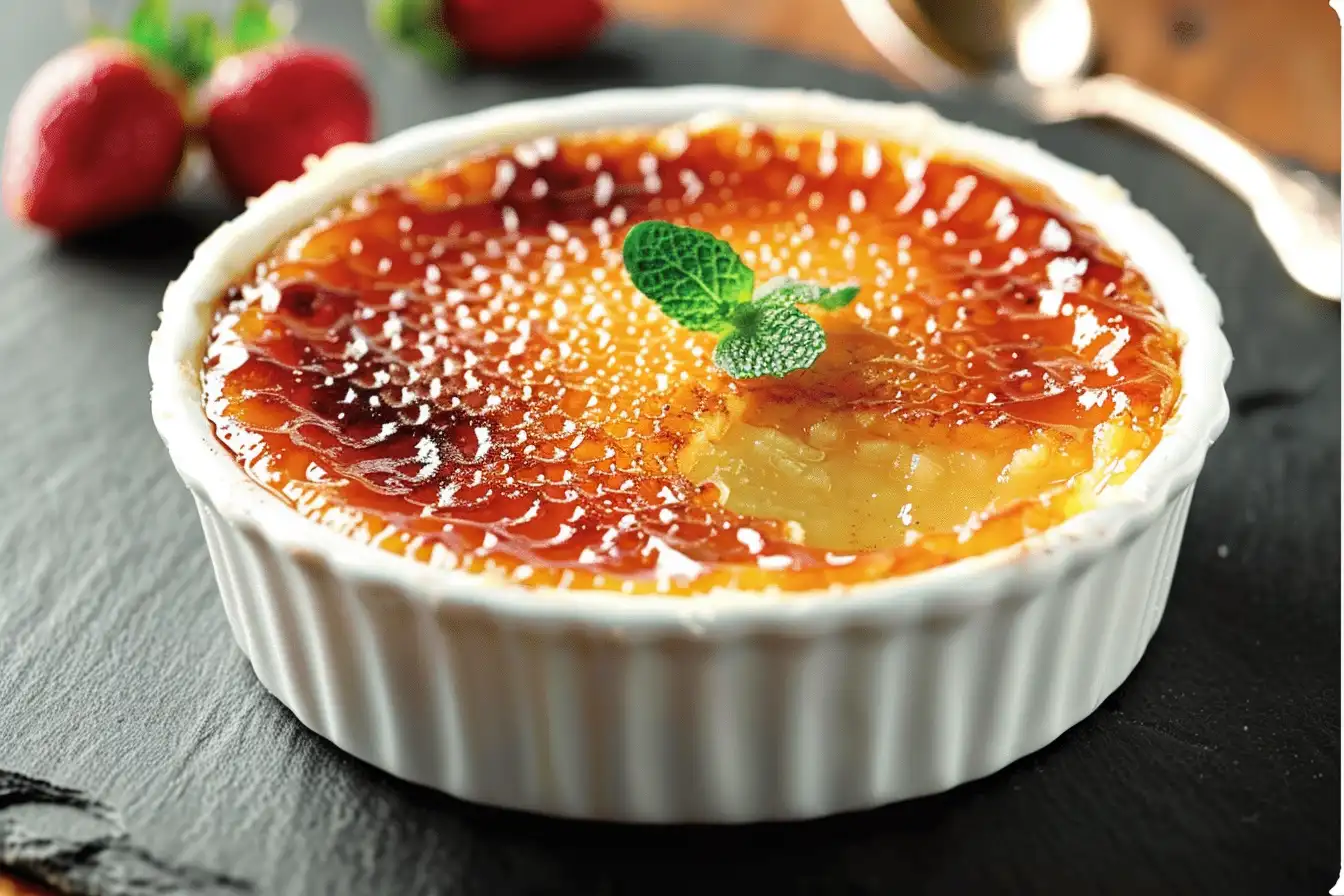Looking to dive into the rich history behind one of the world’s most beloved desserts? This complete Crème Brûlée history timeline traces the fascinating journey of this elegant custard from its mysterious origins to its modern-day popularity. Whether you’re a culinary history buff, a passionate home baker, or simply curious about the stories behind your favorite desserts, this comprehensive guide reveals how a simple combination of cream, eggs, sugar, and fire evolved into an iconic symbol of culinary sophistication.
At mumyrecipes, we’re fascinated by how certain dishes transcend time and cultural boundaries. Crème Brûlée stands as a perfect example—a dessert that has graced the tables of medieval nobility, disappeared into obscurity, and reemerged as a restaurant staple. From heated debates about its national origins to its various historical incarnations and revival, the story of Crème Brûlée reflects broader culinary trends throughout European and global history. Join us as we crack into the crispy, caramelized history of this remarkable dessert!
Jump to:
Origins Debate
The true birthplace of Crème Brûlée remains one of culinary history’s most delicious mysteries, with three countries claiming ownership:
France: The most commonly accepted origin, with the name “crème brûlée” literally translating to “burnt cream.” Early French cookbooks from the 17th century contain recipes resembling modern versions. This French culinary tradition also gave us many other beloved classics, like our Easy French Toast Recipe that shares similar custard-based roots.
England: Proponents of English origin point to “Trinity Cream” or “Cambridge Burnt Cream” from Trinity College, Cambridge in the 17th century. Some historians argue this dessert predates French claims.
Spain: The Catalan dessert “crema catalana” bears striking similarities to crème brûlée and has documentation dating back to medieval Spanish cookbooks, potentially making it the earliest ancestor.
While the debate continues among culinary historians, what’s certain is that variations of custard with caramelized sugar appeared throughout Europe long before any country solidified its claim to invention.

Medieval Beginnings
The earliest documented custard-like desserts date back to the Middle Ages:
- 13th-14th centuries: Early custard recipes appear in European cookbooks, though without the signature burnt sugar top
- Late 14th century: The first recorded custard with sugar topping appears in “Le Viandier,” a collection of recipes attributed to Guillaume Tirel (known as Taillevent), chef to French kings
- 15th century: Spanish “crema catalana” recipes mention an iron branding tool used to caramelize sugar on custard
- Early Middle Ages: Egg custards gain popularity in noble households throughout Europe, as eggs and cream were expensive ingredients signifying wealth and status
During this period, the dessert remained a delicacy for nobility and wealthy merchants, as sugar was an expensive imported commodity and cooking techniques required skilled kitchen staff.
17th-18th Century Evolution
The 17th and 18th centuries saw the refinement of cream custards and the development of more standardized recipes:
- 1691: François Massialot includes a recipe for “crème brûlée” in his cookbook “Le Cuisinier royal et bourgeois,” one of the first definitive French references
- 1731: The English “Burnt Cream” recipe appears in a cookbook by the Earl of Oxford’s chef
- 1769: “The Experienced English Housekeeper” by Elizabeth Raffald includes a recipe for “burnt cream” with a caramelized sugar crust
- Late 18th century: The dessert falls somewhat out of fashion as new, more elaborate French pastries gain prominence during the rise of haute cuisine
During this era, the techniques for caramelizing sugar evolved from using a hot iron rod (salamander) to gradually incorporating more precise methods as kitchen technology advanced.
The Victorian Revival
After a period of relative obscurity, the 19th century brought renewed interest in custard desserts:
- 1879: Trinity College, Cambridge officially adopts “Cambridge Burnt Cream” as a signature dessert, served with the college crest branded into the sugar topping
- 1880s-1890s: French culinary revival brings renewed attention to traditional desserts, including crème brûlée
- Late 19th century: Improved temperature control in ovens allows for more reliable custard preparation
- 1896: Famous chef Auguste Escoffier includes a version of crème brûlée in his collection of recipes, helping to standardize the modern version
This period established many of the techniques still used in traditional crème brûlée preparation today, though the dessert remained primarily a restaurant or special occasion offering rather than a household staple.
20th Century Renaissance
The true renaissance of crème brûlée occurred in the latter half of the 20th century:
- 1950s: Classic French cuisine experiences international revival, bringing renewed interest in traditional French desserts
- 1980s: Crème brûlée experiences a dramatic surge in popularity in the United States, becoming a staple on fine dining menus
- 1982: Chef Alain Sailhac features crème brûlée at Le Cirque in New York, often credited with launching its American popularity
- 1984: New York Times food critic Craig Claiborne declares crème brûlée the “dessert of the decade”
- 1987: The first handheld culinary torch designed specifically for home use reaches the market, making crème brûlée accessible to home cooks
This era transformed crème brûlée from a relatively obscure historical dessert to an icon of sophisticated cuisine found on restaurant menus worldwide.

Modern Global Phenomenon
Today, crème brûlée has achieved global recognition and endless creative variations:
- 1990s-present: Flavor innovations explode, from vanilla bean to lavender, matcha, and even savory versions
- 2000s: Reality cooking shows like “MasterChef” and “Top Chef” frequently feature crème brûlée challenges, cementing its status as a technical benchmark
- 2010s: Social media fuels interest in the dramatic “crack” of breaking through caramelized sugar, making crème brûlée highly “Instagrammable”
- 2020-present: Home cooking revival during global lockdowns brings new interest in creating restaurant-quality desserts at home, including crème brûlée
The dessert has now transcended its European origins to become a truly global phenomenon, with regional adaptations appearing in cuisines around the world. Similar transformations have occurred with other desserts, such as the Thai Mango Sticky Rice: A Comprehensive Guide, which shows how traditional desserts can gain international appeal while maintaining their cultural significance.
Historical Recipes
The evolution of crème brûlée can be traced through its historical recipes:
Medieval Custard (14th century)
- Egg yolks
- Cream or milk
- Sugar or honey
- Spices (often cinnamon, nutmeg, or saffron)
- No burnt sugar top in early versions
François Massialot’s Recipe (1691)
- Egg yolks
- Cream
- Sugar
- Orange flower water
- Caramelized with a hot iron salamander
Elizabeth Raffald’s “Burnt Cream” (1769)
- 1 quart of cream
- 8 egg yolks
- Sugar and cinnamon for flavor
- Sugar for topping, burnt with a salamander
Escoffier’s Classic Recipe (Late 19th century)
- Heavy cream
- Vanilla bean
- Egg yolks
- Sugar
- Caramelized sugar crust (using broiler or salamander)
The core ingredients have remained remarkably consistent over centuries, with the primary evolution being in techniques and flavorings rather than fundamental composition.
Evolution of Techniques
The methods for preparing crème brûlée have evolved dramatically over time:
Caramelization Methods:
- Medieval to 19th century: Hot salamander (metal rod heated in fire)
- 19th century: Broiling under direct flame
- Early 20th century: Salamanders evolved into broiling implements specific to kitchen use
- Late 20th century: Butane and propane culinary torches
- 21st century: Advanced temperature-controlled culinary torches with precision flames
Custard Preparation:
- Early versions: Cooked directly over flame, requiring constant attention
- 18th-19th century: Bain-marie (water bath) method develops for gentler cooking
- 20th century: Precise oven temperature control allows for more reliable results
- Modern era: Sous vide techniques for perfectly consistent custards
Sugar Types:
- Medieval: Raw or partially refined sugar
- 17th-19th century: Refined white sugar becomes more common
- Modern era: Various sugars used for different effects (white, brown, demerara, etc.)
This technical evolution has made the dessert more accessible to home cooks while maintaining its reputation for requiring skill and precision.
Cultural Impact
Beyond its culinary importance, crème brûlée has made significant cultural impacts:
Literary Mentions:
- Featured in numerous 19th century novels as a symbol of luxury
- Marcel Proust’s references to burnt custard in “In Search of Lost Time”
- Modern food literature frequently references the sensory experience of “cracking” the top
Film and Television:
- Amélie (2001): The title character’s joy in cracking crème brûlée became an iconic scene
- Featured in countless cooking competition shows as a test of skill
- “Crème Brûlée” was the focus of a 2007 episode of the sitcom “Friends”
Linguistic Impact:
- The term “crème brûlée moment” entering cultural lexicon to describe the satisfaction of breaking through a barrier
- “Cracking the crème brûlée” as a metaphor for discovering hidden depths
Cultural Status:
- Evolution from royal dessert to middle-class luxury to widespread accessibility
- Symbol of French culinary prestige and technique
- Representation of the perfect balance between contrasting textures (creamy and crunchy)
The dessert has transcended its status as merely food to become a cultural touchpoint and metaphor.
Timeline Highlights
1390s: Early custard recipes appear in medieval cookbooks
1691: First definitive French “crème brûlée” recipe published
1731-1769: English “burnt cream” recipes documented
1879: Trinity College Cambridge version formalized
1896: Escoffier standardizes modern version
1980s: American restaurant renaissance
1987: Home culinary torches introduced
1990s-2000s: Global popularity explosion
2000s-present: Creative variations and home cooking revival
The mumyrecipes Take
There’s something uniquely satisfying about exploring the history of a dessert that has maintained its essential character for centuries. Crème brûlée represents the beautiful intersection of simplicity and sophistication—a dessert that relies on just a handful of ingredients yet requires technique, patience, and a touch of drama in its finishing flame. Its journey from medieval kitchens to global phenomenon reminds us that truly great culinary creations can transcend time, national boundaries, and changing tastes.
What’s particularly remarkable about crème brûlée is how little the fundamental recipe has changed over hundreds of years. While we may now have more precise tools and exotic flavor variations, the essential pleasure remains unchanged: that magical moment when spoon breaks through crisp caramelized sugar into creamy custard below. In a world of fleeting food trends, crème brûlée stands as a testament to timeless perfection.
Ready to experience this historical dessert yourself? Check out our [Crème Brûlée recipe] for a classic version that honors centuries of tradition, or explore the fascinating [Origins of Crème Brûlée] for a deeper dive into the competing national claims. And don’t forget to subscribe to our newsletter for more delicious food history delivered straight to your inbox!

